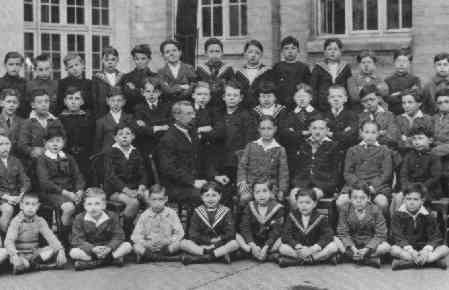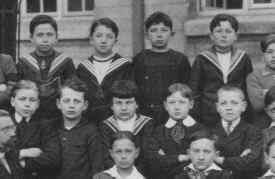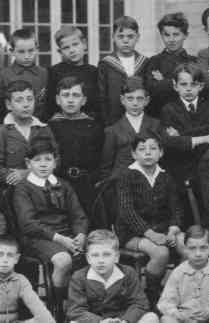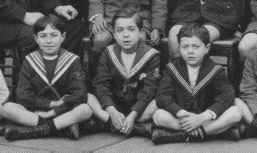
Figure 1.--This German class shows that boys age about 9-11 wore mostly suits and sailor suits to class, but some boys wore just sweaters and some wear French-looking smocks.


Figure 1.--This German class shows that boys age about 9-11 wore mostly suits and sailor suits to class, but some boys wore just sweaters and some wear French-looking smocks. |
German schools after the First World War continued the policy of allowing boys to wear the clothes parents selected for them. Given the horrors of the First World War it is understandable that German parents would have little reason to develop an interest in uniforms for school children, although the War did not affect British opinions on uniforms. Interestingly, sailor suits continued to be a popular style for boys, including older boys than wore sailor suits--both with short and long pants. This varied from Britain and America where it became increasingly rare in the 1920s for older boys to wear them. A few boys also wore smocks, at least in the early 1920s. Most boys that didn't wear sailor suits, however, wore short pants suits of various designs.

Figure 2.--Two of thse boys are wearing smocks. One with no apparent collar oe bow, the other with a wide white collar and bow. Only a small number of the boys in this class wear smocks. |
I do not have details on this class. I do not know what type of school it is or where it is located. The boys appear to be about 9 to 11. They have a lady teacher. There may be one girl in the photograph (the rear right), bit it may be a boy with long hair.
There is sustantial variety of clothes worn by the boys. All the boys except two of the sailor suited boys appear to wear short pants. The following styles are worn:

Figure 3.--Three boys here wear smocks, but note the varied styles: a plain one, a smock with a sailor collar, and one with a wide collar and bow. Another boys wears a British-looking striped blazer. |
Smocks appear to have been more common in the tears before World War I. Several boys, however, stillwear smocks, but only a small fraction of the class. I'm not sure if this was thought of as more of a French style. Perhaps this school was in a town near the French boorder. I am also unsure what the boys thought of wearing smocks. I haven't seen photographs of German boys much older than this wearing smocks. Thus it is likely the
style was not popular. The smocks are of widely varying styles. One boy has a smock with buttons set over to
the side. Another boy has a smock with a prominent belt. Some boys wear
smocks with broad white collars and bows. Others boys have smocks with no
collars at all. One boy appears to have a sailor collar on his smock.
All of the smocks appear to be either dark blue or
black.
The sailor suit was still extremely popular for boys. German boys in the 1920s wore a wide variety of
sailor suits. Some had long pants, but most had short pants. The
pants were mostly blue, but both white and blue middy blouses were worn. Most but not all had had classic three stripe styling. All had long sleaves, some with the three strips at the cuff. They were all worn with bows, but the bows varied widely. The most common style is a dickey without any decoration.
Many of the boys have sailor suits with rank decorations on the sleave. Only one boy has a decoration on his middy blouse dickey. All of the sailor suits appear to be dark blue ones.
Quite a few boys are dressed in sweaters without
jackets. None of these boys wear ties.
The boys wearing suits are mostly wearing open neck shirts. Many of the shirts have prominent if not large open necked collars. Other boys have no prominent collars at all with their jackets. Several boys in suits wear ties, but more wear open necked
shirts. One boy has been dresses with a bow. Single-breasted jackets are
the most common. Many of the jackets are havily influence by the Norfolk
style with front pockets and
belts.
Most boys are wearing dark socks. Several are kneesocks, but mos are worn at calf length. None appear to be turn-over-top socks as were commonly worn by British boys at the time. They are old solid
colrs, but dark colors are the most common. One boy in a sailor suit wears whire kneesocks. Another sailor suited boy wears white kneesocks with patterened tops.

Figure 4.--German boys wore sailor suits with both long and short pants, but shorts were the most common. |
The boys in the photograph mostly wear medium hair cuts. One boy has a very short cut, a style popular before World War I (1914-18) when the
German military was held in higher regard. Only one boy has longer hair covering his ears. He wears Dutch boy bangs and wears a sailor suit.
Related Chronolgy Pages in the Boys' Historical Web Site
[Main Chronology Page]
[The 1900s]
[The 1910s]
[The 1920s]
[The 1930s]
Navigate the German school pages
[Main school uniform page]
[Main school uniform national page]
[Main German school uniform page]
[Imperial Germany]
[Weimar Republic]
[NAZI era]
[Post-war Years]
[Unified Germany]
Navigate the Relate Boys Historical Clothing Style Pages
[Main country page]
[Long pants suits]
[Short pants suits]
[Lederhosen]
[Kneesocks]
[Eton suits]
[Jacket and trousers]
[Blazer
[School sandals]
